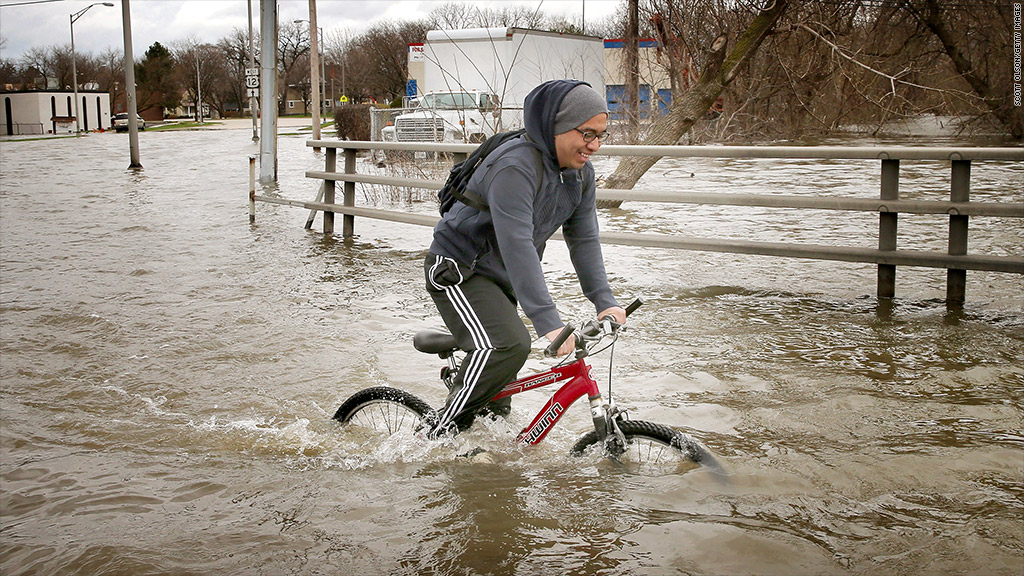
The U.S. flood alarm system is about to get smaller.
On May 1, the U.S. Geological Survey began turning off some 150 stream gauges that monitor water levels on the nation's rivers and streams, thanks to the federal spending cuts, also known as sequester.
It's a one-two punch for the flood monitoring system -- the agency could be turning off another 200 gauges because of funding cutbacks at states, cities and towns that are struggling with their own budget crises.
Water science experts warn that turning off the gauges will weaken the monitoring system that helps communities prepare for floods.
"We're trying to be very careful about which ones we say aren't going to receive funding," said Michael Norris, coordinator for the National Streamflow Information Program. The group has been been working for months to figure out which gauges are the least critical. "The last thing we want to do is put anyone's life or property in danger."
Related: Federal worker hard at work on furlough week
The gauges allow the National Weather Service to forecast floods and help the U.S. Army Corp of Engineers manage its water reservoirs.
"Without these observations, (our) forecast and warning operations will be impaired, reduced, or discontinued on a location-by-location basis," said Christopher Vaccaro, a weather service spokesman.
The cuts couldn't come at a worse time. Scientists have pointed that climate change has led to record floods recently, similar to the one that plagued Midwestern states two weeks ago.
Climate change continues to lead to "more unusual weather events than we used to have," said Donald Wuebbles, a professor of atmospheric sciences at the University of Illinois at Urbana-Champaign.
In fact, climate change was one reason President Obama proposed spending an additional $7.2 million to fund an extra 400 stream gauges next year, according to budget documents.
Floods kill 95 people each year and cause about $8 billion in property damage, according to the National Weather Service. Last October, Superstorm Sandy killed 72 people and caused $50 billion in damage.
The National Stream Flow Information Program is one of thousands of federal programs facing federal budget cuts. The program took a $2 million direct hit to its 2013 funding.
Related: IRS workers protest spending cuts
The Geological Survey is facing its own budget cuts and may have to furlough employees later this year. It's been under a hiring freeze and has cut back on employee travel and trimmed contracts for maintaining and upgrading its databases.

The water gauge instruments aren't cheap. They cost on average $16,000 apiece and upkeep is expensive -- officials must check on the instruments about six times a year to make sure they are running properly.
The water level measurements are not just used by the weather service. Boaters, kayakers and other water enthusiasts keenly follow the water levels that the agency broadcasts online.
The decision to turn off any one gauge is a tough one because of the implications, say water experts at state offices.
In the early 1990s, federal budget cuts forced more than 350 gauges to be turned off, including one on the Licking River at McKinneysburg, Kentucky.
In 1997, thunder storms caused record-breaking floods in the Licking River of up to 52 feet, which inundated the town of Falmouth and killed five people. Better data on that river might have saved lives, officials have said.
"In that particular case, loss of that stream gauge was devastating," Norris said.
So far, gauges have been shut down in states like Kansas, Nebraska and Wyoming.
In Iowa, three gauges will be turned off next week. Greg Nalley, associate director for Iowa Water Science Center, said he worked closely with the National Weather Service to find the least critical gauges. Those three were chosen, because other stream gauges exist upstream or downstream on those waterways.
"We don't like losing any of them, but we haven't got a choice," Nalley said.


